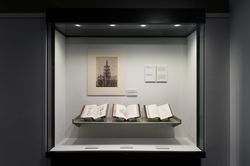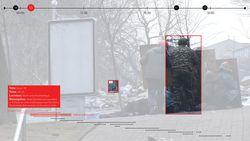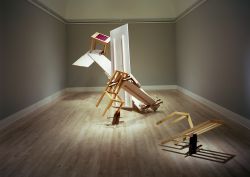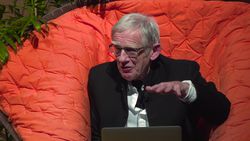drawings
Quantity:
37 design development drawing(s)
AP140.S2.SS1.D31.P3
Description:
set of numbered drawings (dated September 1966) showing floor plans (including a basement plan with underground parking garage and ramp), cross sections, a longitudinal section, a bird's-eye plan oblique, and plans for typical furnished students' rooms; includes sets of drawings and sketches comprising floor plans and cross sections, a cross section and ground floor plan (dated February 1967) showing a parking garage below the modified A-frames, a few preliminary plans and cross sections at a larger scale, and preliminary plans for typical furnished students' rooms; there is a group of design development drawings (dated June 1967) on a larger format of paper, consisting of floor plans, plans for typical furnished students' rooms, cross sections, a partial section, longitudinal sections, elevations, and sectional elevations, and there is a bird's-eye plan oblique (dated September 1967)
1966-1967
Set of numbered drawings
Actions:
AP140.S2.SS1.D31.P3
Description:
set of numbered drawings (dated September 1966) showing floor plans (including a basement plan with underground parking garage and ramp), cross sections, a longitudinal section, a bird's-eye plan oblique, and plans for typical furnished students' rooms; includes sets of drawings and sketches comprising floor plans and cross sections, a cross section and ground floor plan (dated February 1967) showing a parking garage below the modified A-frames, a few preliminary plans and cross sections at a larger scale, and preliminary plans for typical furnished students' rooms; there is a group of design development drawings (dated June 1967) on a larger format of paper, consisting of floor plans, plans for typical furnished students' rooms, cross sections, a partial section, longitudinal sections, elevations, and sectional elevations, and there is a bird's-eye plan oblique (dated September 1967)
drawings
Quantity:
37 design development drawing(s)
1966-1967
drawings
DR1988:0433:027
Description:
- Drawing showing designs for four different types of dormer windows of Fonthill House, Wiltshire. Two windows have triangular pediments, while the others have semi-circular pediments. - One of a group of working drawings for William Burn's October 1849 project for Fonthill House, Wiltshire, a country house designed in the Jacobethan style. This group represents only one of the projects that Burn proposed for Fonthill House; the final project, executed in 1856, was much smaller (Walker, 31, illustrated in Hitchcock, vol. 2, fig. VIII 31). Drawings include plans, elevations, and sections, as well as full-scale drawings of masonry details. Approximately half of the drawings are part of a numbered series from one to twenty-two, while the other drawings, mostly masonry details, were not numbered. These latter drawings are not as carefully finished, and a few are incomplete.
architecture
October 1849
Elevations and profiles for four types of dormer windows for Fonthill House
Actions:
DR1988:0433:027
Description:
- Drawing showing designs for four different types of dormer windows of Fonthill House, Wiltshire. Two windows have triangular pediments, while the others have semi-circular pediments. - One of a group of working drawings for William Burn's October 1849 project for Fonthill House, Wiltshire, a country house designed in the Jacobethan style. This group represents only one of the projects that Burn proposed for Fonthill House; the final project, executed in 1856, was much smaller (Walker, 31, illustrated in Hitchcock, vol. 2, fig. VIII 31). Drawings include plans, elevations, and sections, as well as full-scale drawings of masonry details. Approximately half of the drawings are part of a numbered series from one to twenty-two, while the other drawings, mostly masonry details, were not numbered. These latter drawings are not as carefully finished, and a few are incomplete.
drawings
October 1849
architecture
The Anatomy of the Architectural Book, an exhibition presented in conjunction with the publication of a book of the same title by André Tavares, examines the relationships between book culture and building culture, making visible the axes along which architectural knowledge circulates through books into buildings and back. Through seven themes—Texture, Spread, Sequence,(...)
10 May 2016 to 20 November 2016
The Anatomy of the Architectural Book
Actions:
Description:
The Anatomy of the Architectural Book, an exhibition presented in conjunction with the publication of a book of the same title by André Tavares, examines the relationships between book culture and building culture, making visible the axes along which architectural knowledge circulates through books into buildings and back. Through seven themes—Texture, Spread, Sequence,(...)
Series
AP193.S1
Description:
Series 1, Water Flux and Scrambled Flat, 2002-2010, documents the conception and evolution of a project that was originally a farm building and later became a geology and glaciology museum and research center focused on the Swiss Alps. The project was never realized. R&Sie(n) conceptualized Scrambled Flat as an experimental farm. The project goal was to reconcile European Union’s agricultural regulations, imposing a separation between animal and human living, to the community of Évolène traditional way of living, contiguously with animals, benefiting from the resources they offer. As conceived, Scrambled Flat creates an environment where fluidity between the existence of the animals and the humans is materialized. The size of the form is also adapted from a typical local rural house and exploits the heat of the animals and the insulation of the hay. For this project, R&Sie(n) approached the mayor of the community with the design proposition. The mayor then called for a competition, while also changing the program to an ecology museum and research center illustrating the local effects of global warming and the thawing of the Alps. R&Sie(n) won the competition with Water Flux, a reinterpretation of Scrambled Flat. The project was intended to uncover and exorcise the anxieties of ecological disaster, and the principle of flux related to seasonal change and, more broadly, climate change. The firm designed rooms that reproduce the geological and meteorological environment of the high mountains making it visible and experimental, offering refrigerated spaces for art installations and scientific demonstrations. The concept was also to build with the use of new technologies such as digital modelling, point scanning, and computer numerical control (CNC), combined with ancient local knowledge of knocking on trees to decide which specific pines have the best wood for construction. The building is designed to be constructed with local lamellar wood milled by nearby CNC. The resulting parts would be used for the structure, the insulation, the waterproofing and both the interior and exterior finishes. The design includes a grille wrapping the building, reproducing the profile of traditional houses and enclosure and making it possible to hold the snow inside a typo-morphological imprint. Therefore, the transformable envelope of the building reacts to the rhythm of the seasons. In the winter, the structure would appear like a solid cut-out of ice and snow, with cavities similar to those found in glaciers. In the summer, it would resemble piles of stones used in these areas to make borders. A small pool would collect rainwater and supply it to an interior artificial snowmaking system designed for the gallery. Transformation of the water is an integral part of the design. The records contain images of plans, sections, details for the structure of the façade, renderings, plans of the engineered structure, and photographs documenting the conception of the models with the CNC machinery. The Rhino 3D modelling files are also part of the records along with AutoCAD models and a video documenting the process. The records contain two physical models: a smaller polymer model at 1:20 scale representing the whole structure of the building, and a larger 1:1 latch wood fragment representing detail of the structure in its integrality.
2002-2010
Water Flux and Scrambled Flat
Actions:
AP193.S1
Description:
Series 1, Water Flux and Scrambled Flat, 2002-2010, documents the conception and evolution of a project that was originally a farm building and later became a geology and glaciology museum and research center focused on the Swiss Alps. The project was never realized. R&Sie(n) conceptualized Scrambled Flat as an experimental farm. The project goal was to reconcile European Union’s agricultural regulations, imposing a separation between animal and human living, to the community of Évolène traditional way of living, contiguously with animals, benefiting from the resources they offer. As conceived, Scrambled Flat creates an environment where fluidity between the existence of the animals and the humans is materialized. The size of the form is also adapted from a typical local rural house and exploits the heat of the animals and the insulation of the hay. For this project, R&Sie(n) approached the mayor of the community with the design proposition. The mayor then called for a competition, while also changing the program to an ecology museum and research center illustrating the local effects of global warming and the thawing of the Alps. R&Sie(n) won the competition with Water Flux, a reinterpretation of Scrambled Flat. The project was intended to uncover and exorcise the anxieties of ecological disaster, and the principle of flux related to seasonal change and, more broadly, climate change. The firm designed rooms that reproduce the geological and meteorological environment of the high mountains making it visible and experimental, offering refrigerated spaces for art installations and scientific demonstrations. The concept was also to build with the use of new technologies such as digital modelling, point scanning, and computer numerical control (CNC), combined with ancient local knowledge of knocking on trees to decide which specific pines have the best wood for construction. The building is designed to be constructed with local lamellar wood milled by nearby CNC. The resulting parts would be used for the structure, the insulation, the waterproofing and both the interior and exterior finishes. The design includes a grille wrapping the building, reproducing the profile of traditional houses and enclosure and making it possible to hold the snow inside a typo-morphological imprint. Therefore, the transformable envelope of the building reacts to the rhythm of the seasons. In the winter, the structure would appear like a solid cut-out of ice and snow, with cavities similar to those found in glaciers. In the summer, it would resemble piles of stones used in these areas to make borders. A small pool would collect rainwater and supply it to an interior artificial snowmaking system designed for the gallery. Transformation of the water is an integral part of the design. The records contain images of plans, sections, details for the structure of the façade, renderings, plans of the engineered structure, and photographs documenting the conception of the models with the CNC machinery. The Rhino 3D modelling files are also part of the records along with AutoCAD models and a video documenting the process. The records contain two physical models: a smaller polymer model at 1:20 scale representing the whole structure of the building, and a larger 1:1 latch wood fragment representing detail of the structure in its integrality.
Series
2002-2010
drawings
DR1981:0024
Description:
- DR1981:0024 shows a design for what appears to be an ornamental footbridge. No dimensions are given and materials are not indicated, but the structure could not have been erected at a very large scale. The road bed consists of three sections: a central flat section supported on a broad flat arch; and two gently-sloped side sections, each supported on seven small, round-headed arches. The span of the bridge is braced between two sets of double piers. Each of these four piers carries an octagonal kiosk consisting of closed panels below and an open framework above. At the centre of the bridge rises a pavilion formed of sixteen columns on a rectangular plan (six columns on each of the two long sides) supporting a curved gable roof. Above the road bed, the superstructure is decorated with banners, lanterns, fretwork, and inscriptions, all in a style of Chinese derivation.
architecture, landscape architecture
ca. 1763
Design for a bridge in the Chinese style to be erected at Sanssouci
Actions:
DR1981:0024
Description:
- DR1981:0024 shows a design for what appears to be an ornamental footbridge. No dimensions are given and materials are not indicated, but the structure could not have been erected at a very large scale. The road bed consists of three sections: a central flat section supported on a broad flat arch; and two gently-sloped side sections, each supported on seven small, round-headed arches. The span of the bridge is braced between two sets of double piers. Each of these four piers carries an octagonal kiosk consisting of closed panels below and an open framework above. At the centre of the bridge rises a pavilion formed of sixteen columns on a rectangular plan (six columns on each of the two long sides) supporting a curved gable roof. Above the road bed, the superstructure is decorated with banners, lanterns, fretwork, and inscriptions, all in a style of Chinese derivation.
drawings
ca. 1763
architecture, landscape architecture
The expanded role: SITU
Bradley Samuels presents recent SITU Research work and the role that research plays within the larger practice of SITU as a whole. A series of case studies will be presented which explore an expanded role for architectural and spatial practice across a range of fields—from human rights and public policy to earth science and workspace design. SITU Research’s past work(...)
Paul-Desmarais Theatre
14 January 2016
The expanded role: SITU
Actions:
Description:
Bradley Samuels presents recent SITU Research work and the role that research plays within the larger practice of SITU as a whole. A series of case studies will be presented which explore an expanded role for architectural and spatial practice across a range of fields—from human rights and public policy to earth science and workspace design. SITU Research’s past work(...)
Paul-Desmarais Theatre
Parables and Other Allegories: The Work of Melvin Charney 1975–1990 comprises approximately 100 drawings, including many large-scale, sketches, photographs, and three large constructions. By assembling works from various public and private collections, including the CCA, the exhibition permits a comprehensive analysis of Charney’s artistic process to reveal the dialogue(...)
Main galleries
9 October 1991 to 12 January 1992
Parables and Other Allegories: The Work of Melvin Charney, 1975-1990
Actions:
Description:
Parables and Other Allegories: The Work of Melvin Charney 1975–1990 comprises approximately 100 drawings, including many large-scale, sketches, photographs, and three large constructions. By assembling works from various public and private collections, including the CCA, the exhibition permits a comprehensive analysis of Charney’s artistic process to reveal the dialogue(...)
Main galleries
Individuals act as their own historians, suppressing some stories and emphasizing others. But at the scale of nations and cultures, and especially in this age of ubiquitous digital memory, it has become more difficult to forget. Building on questions about history and its uses, raised by exhibitions like Educating Architects: Four Courses by Kenneth Frampton and Besides,(...)
7 December 2017
Come and Forget the Internet, with Evgeny Morozov
Actions:
Description:
Individuals act as their own historians, suppressing some stories and emphasizing others. But at the scale of nations and cultures, and especially in this age of ubiquitous digital memory, it has become more difficult to forget. Building on questions about history and its uses, raised by exhibitions like Educating Architects: Four Courses by Kenneth Frampton and Besides,(...)
Individuals act as their own historians, suppressing some stories and emphasizing others. But at the scale of nations and cultures, and especially in this age of ubiquitous digital memory, it has become more difficult to forget. Building on questions about history and its uses, raised by exhibitions like Educating Architects: Four Courses by Kenneth Frampton and Besides,(...)
Craig Hodgetts
29 March 2018
Come and Forget the Grid, with Craig Hodgetts
Actions:
Description:
Individuals act as their own historians, suppressing some stories and emphasizing others. But at the scale of nations and cultures, and especially in this age of ubiquitous digital memory, it has become more difficult to forget. Building on questions about history and its uses, raised by exhibitions like Educating Architects: Four Courses by Kenneth Frampton and Besides,(...)
Craig Hodgetts
Individuals act as their own historians, suppressing some stories and emphasizing others. But at the scale of nations and cultures, and especially in this age of ubiquitous digital memory, it has become more difficult to forget. Building on questions about history and its uses, raised by exhibitions like Educating Architects: Four Courses by Kenneth Frampton and Besides,(...)
Johannes Grenzfurthner
12 April 2018
Come and Forget the Counterculture, with Johannes Grenzfurthner
Actions:
Description:
Individuals act as their own historians, suppressing some stories and emphasizing others. But at the scale of nations and cultures, and especially in this age of ubiquitous digital memory, it has become more difficult to forget. Building on questions about history and its uses, raised by exhibitions like Educating Architects: Four Courses by Kenneth Frampton and Besides,(...)
Johannes Grenzfurthner





